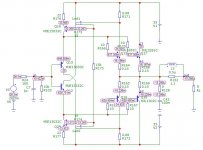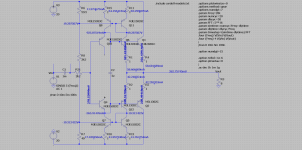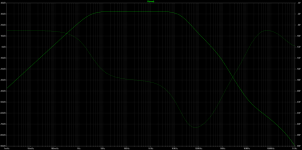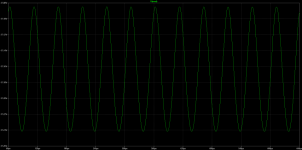I didn't understand it well enough, nor could I get a satisfactory simulation running and didn't want to bench test it. So I didn't adopt it. I did include the basic buffer - you can see it somewhere earlier in this thread if you scroll back up.
DC conditions from the simulation, it all looks fine and operating well with Cordell`s models.
Modulating ccs trick has a little effect on the distortion in the simulation.
Attachments
Member
Joined 2009
Paid Member
YES!
The circuit works well.
But I was never happy about THD. It is higher than industry standards although it sounded wonderful.
Amusingly the Melbourne Audio Club resoundingly loved it but were not thrilled with the the figures.
Such is life....
HD
Did you build it exactly like from the scan from this post? TGM11 - no GNFB - inspired by Steven Dunlap 'KRILL'
I've not tried simulating real speakers - would be willing to try if anybody has a favourite equivalent circuit.
Real-Life Measurements Page 2 | Stereophile.com
Patrick
YES!
The circuit works well.
But I was never happy about THD. It is higher than industry standards although it sounded wonderful.[....]
Hugh, I assume the output stage was open loop? If citing industry standard, do you count in also closed loop output stages, or compare to the few open loop designs like Ayre, or some Pass designs who run the OP open loop?
What is the effect on output impedance / damping factor? I assume it should be lower, as there is some positive feedback, as you already hinted.[...]
Modulating ccs trick has a little effect on the distortion in the simulation.
And the real thing :
http://www.diyaudio.com/forums/solid-state/91479-simple-cheap-load-2.html#post1073195
Patrick
http://www.diyaudio.com/forums/solid-state/91479-simple-cheap-load-2.html#post1073195
Patrick
Last edited:
I would say this, as Hugh gave Bigun the schematic....Did you build it exactly like from the scan from this post? TGM11 - no GNFB - inspired by Steven Dunlap 'KRILL'
http://www.diyaudio.com/forums/soli...spired-steven-dunlap-krill-4.html#post5523804
Did you build it exactly like from the scan from this post? TGM11 - no GNFB - inspired by Steven Dunlap 'KRILL'
Pawel,
I think so, but it was a long time ago, more than 7 years ago and a brain injury! For a couple of years 2012-2014 much of my memory is hazy.....
Sottomano,
Yes, it was open loop. There was no closed loop back to the VAS, but there was heavy feedback from first to second stage. The Zout was pretty low, about DF of 40 actually, it drove a 87dB/watt/metre speaker well in a large auditorium with 110 people in attendance. I measured H2 at around 63dB down, THD around 0.1% at +20dB, followed with higher orders decreasing linearly at about 5dB each. What was really surprising was the sound quality; quite beautiful.
I moved on and my latest product, the Maya II, uses a simple source follower with very high gm mosfets. I do have global fb but keep it to about 30dB, most of the OLG is absorbed in nested fb.
On reflection I think there is a product here, but it is quite difficult to finesse it across the wide operating points we need for high end. And setting up a stable quiescent is tricky, the CCS is tetchy.
HD
Last edited:
Member
Joined 2009
Paid Member
Pawel,
I think so, but it was a long time ago, more than 7 years ago and a brain injury! For a couple of years 2012-2014 much of my memory is hazy.....
Sottomano,
Yes, it was open loop. There was no closed loop back to the VAS, but there was heavy feedback from first to second stage. The Zout was pretty low, about DF of 40 actually, it drove a 87dB/watt/metre speaker well in a large auditorium with 110 people in attendance. I measured H2 at around 63dB down, THD around 0.1% at +20dB, followed with higher orders decreasing linearly at about 5dB each. What was really surprising was the sound quality; quite beautiful.
I moved on and my latest product, the Maya II, uses a simple source follower with very high gm mosfets. I do have global fb but keep it to about 30dB, most of the OLG is absorbed in nested fb.
On reflection I think there is a product here, but it is quite difficult to finesse it across the wide operating points we need for high end. And setting up a stable quiescent is tricky, the CCS is tetchy.
HD
Dear Hugh!
with the value similar to proposed by you the circuit works as follow (it has the gain!!!),
what needs to be regulated?
Attachments
But you are mirroring the current of one output pair 1:1 if i see it correctly (small picture-old eyes). If that's the case, it is way off what Hugh proposed.Dear Hugh!
with the value similar to proposed by you the circuit works as follow (it has the gain!!!),
what needs to be regulated?
There is no gain but there is current manipulation. All voltage processing is a simple input base to emitter and second stage base to output emitter.
The distortion is created by differential Vbe steps arising from increasing output device Vbe and reducing Vbe at the drivers. To reduce these differentials we should arrange driver current increasing faster than the output base current demand. These currents are not linear because beta drops as output peaks.
The outcome is a spray of low order artefacts, H2 to H12. The profile is not identical to the profile driven from cross over. What surprised me was the good sound quality.
Pawel your Spice file sets only 20V rail. All my experiments used a 56V rail and things hot up at high power.
HD
The distortion is created by differential Vbe steps arising from increasing output device Vbe and reducing Vbe at the drivers. To reduce these differentials we should arrange driver current increasing faster than the output base current demand. These currents are not linear because beta drops as output peaks.
The outcome is a spray of low order artefacts, H2 to H12. The profile is not identical to the profile driven from cross over. What surprised me was the good sound quality.
Pawel your Spice file sets only 20V rail. All my experiments used a 56V rail and things hot up at high power.
HD
- Status
- This old topic is closed. If you want to reopen this topic, contact a moderator using the "Report Post" button.
- Home
- Amplifiers
- Solid State
- TGM11 - no GNFB - inspired by Steven Dunlap 'KRILL'



